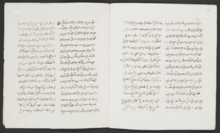| Pantun | |
|---|---|
 | |
| Country | Malaysia, Brunei and Indonesia |
| Reference | 01613 |
| Region | Asia and the Pacific |
| Inscription history | |
| Inscription | 2020 |
Pantun (Jawi: ڤنتون) is a Malayic oral poetic form used to express intricate ideas and emotions.[1] It generally consists of even-numbered lines[2] and based on ABAB rhyming schemes.[3] The shortest pantun consists of two lines better known as the pantun dua kerat in Malay, while the longest pantun, the pantun enam belas kerat have 16 lines.[4] Pantun is a disjunctive form of poetry which always come in two parts, the first part being the prefatory statement called pembayang or sampiran that has no immediate logical or the narrative connection with the second or closing statement called maksud or isi.[5][6][7][8][9] However, they are always connected by the rhymes and other verbal associations, such as puns and repeating sounds.[10] There is also an oblique but necessary relationship and the first statement often turns out to be a metaphor for the second one.[11] The most popular form of pantun is the quatrain (four lines),[12] and the couplet (two-lines),[13] which both featured prominently in the literature and modern popular culture.[14]
The earliest literary records of pantun date back to the 15th century Malacca Sultanate,[15] although some historians believe that pantun may be as old, or precedes the Classical Malay language itself, grew and spread during the Srivijaya era, where the founder of Malacca was from. Pantun during Malacca era was featured in the most important Malay literary text, the Malay Annals[16] and is regarded as a high art and has been the integral part of classical Malay literature. It also thrived as a natural part in the daily communication of traditional Malay society and served as the important expressive tool in Malay songs,[17] rituals, performing arts and in all form of storytelling.[18]
- ^ Wilkinson 1908, p. 28
- ^ Daillie 1988, p. 38
- ^ Hirsch 2014, p. 440
- ^ Daillie 1988, p. 38
- ^ Wright 1908, p. 230
- ^ Hirsch 2014, p. 440
- ^ "Pantun". ich.unesco.org. United Nations Educational, Scientific and Cultural Organization (UNESCO). 2020. Retrieved 20 January 2021.
- ^ Milyartini, Rita (2018). "Singing Keroncong and the Values Behind it". Proceedings of the International Conference on Arts and Design Education (ICADE 2018). Vol. 255. pp. 137–138. doi:10.2991/icade-18.2019.31. ISBN 978-94-6252-671-6. Retrieved 21 January 2021.
{{cite book}}:|journal=ignored (help) - ^ Chadwick, R.J. (1994). "Unconsummated metaphor in the Minangkabau pantun". School of Oriental & African Studies. 22 (1994): 83–113. doi:10.1080/03062849408729808. Retrieved 21 January 2021.
- ^ Hirsch 2014, p. 440
- ^ Hirsch 2014, p. 440
- ^ Hirsch 2014, p. 440
- ^ Muhammad Haji Salleh 2018, p. 46
- ^ Ding 2008, p. 13
- ^ Hirsch 2014, p. 440
- ^ Winstedt 1969, p. 137
- ^ Liaw 2013, p. 442
- ^ Ding 2008, p. 6,7 & 13